INSTITUT SUPERIEUR D'ANTHROPOLOGIE
INSTITUTE OF ANTHROPOLOGY
ONLINE COURSES / COURS A DISTANCE
INSCRIPTION : Année Universitaire 2012/2013
REGISTRATION : Academic Year 2012 / 2013
FRANCE – 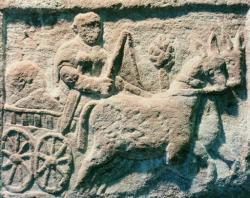 – Strasbourg - Des fouilles menées au pied de la cathédrale de Strasbourg ont permis de mettre au jour des peintures murales «d’une grande qualité» issues d’un camp romain installé dans les années 90 de notre ère, ont expliqué mercredi les responsables de ces recherches archéologiques. L’équipe de l’Inrap a trouvé, dans une petite tranchée profonde de 3 mètres, plusieurs murs d’un secteur qui avait abrité les maisons de tribuns et de centurions de la VIIIe légion Auguste. Sur l’une des cloisons effondrées, les archéologues ont découvert de chaque côté «une peinture murale d’une grande qualité, dont l’une représente des colonnes et un panneau encadrant une femme debout», a indiqué à la presse Heidi Cicutta, responsable scientifique à l’Inrap. L’autre «se compose d’une belle guirlande rouge dotée d’un noeud vert». «Cerise sur le gâteau», un graffiti de six lignes a été découvert, qui sera déchiffré par un expert, a ajouté Mme Cicutta. La VIIIe légion Auguste s’était installé dans l’antique Argentorate (premier nom de Strasbourg) dans les années 90 après Jésus-Christ, avec ses 6.000 hommes qui y bâtirent un camp fixe de 20 hectares, au coeur de l’actuel centre historique de la capitale alsacienne. Lors de ces fouilles menées dans le cadre d’un réaménagement du site, les archéologues ont également pu exhumer les vestiges du chantier de construction de la cathédrale de Strasbourg, érigée de 1180 à 1439, dans le style roman puis gothique. Ils ont notamment dégagé des niveaux de circulation foulés par les bâtisseurs, constitués des éclats de grès étalés par les tailleurs de pierre. «Ces déchets nous donnent des informations sur les techniques des artisans» qui ont bâti la cathédrale, a expliqué la responsable.
– Strasbourg - Des fouilles menées au pied de la cathédrale de Strasbourg ont permis de mettre au jour des peintures murales «d’une grande qualité» issues d’un camp romain installé dans les années 90 de notre ère, ont expliqué mercredi les responsables de ces recherches archéologiques. L’équipe de l’Inrap a trouvé, dans une petite tranchée profonde de 3 mètres, plusieurs murs d’un secteur qui avait abrité les maisons de tribuns et de centurions de la VIIIe légion Auguste. Sur l’une des cloisons effondrées, les archéologues ont découvert de chaque côté «une peinture murale d’une grande qualité, dont l’une représente des colonnes et un panneau encadrant une femme debout», a indiqué à la presse Heidi Cicutta, responsable scientifique à l’Inrap. L’autre «se compose d’une belle guirlande rouge dotée d’un noeud vert». «Cerise sur le gâteau», un graffiti de six lignes a été découvert, qui sera déchiffré par un expert, a ajouté Mme Cicutta. La VIIIe légion Auguste s’était installé dans l’antique Argentorate (premier nom de Strasbourg) dans les années 90 après Jésus-Christ, avec ses 6.000 hommes qui y bâtirent un camp fixe de 20 hectares, au coeur de l’actuel centre historique de la capitale alsacienne. Lors de ces fouilles menées dans le cadre d’un réaménagement du site, les archéologues ont également pu exhumer les vestiges du chantier de construction de la cathédrale de Strasbourg, érigée de 1180 à 1439, dans le style roman puis gothique. Ils ont notamment dégagé des niveaux de circulation foulés par les bâtisseurs, constitués des éclats de grès étalés par les tailleurs de pierre. «Ces déchets nous donnent des informations sur les techniques des artisans» qui ont bâti la cathédrale, a expliqué la responsable.
http://www.lalsace.fr/actualite/2012/08/29/strasbourg-des-fouilles-mettent-au-jour-des-peintures-murales-d-une-legion-romaine
BULGARIE – 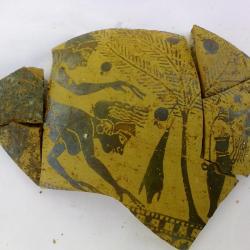 Sozopol - Archaeologists discovered a necropolis of ancient Apollonia in the coastal town of Sozopol, Director of the Museum of History in Sozopol Dimitar Nedev announced for FOCUS News Agency. In Nedev’s words, the burial was found in the northern part of the narthex of the three-naved basilica under the levels of the two churches.
Sozopol - Archaeologists discovered a necropolis of ancient Apollonia in the coastal town of Sozopol, Director of the Museum of History in Sozopol Dimitar Nedev announced for FOCUS News Agency. In Nedev’s words, the burial was found in the northern part of the narthex of the three-naved basilica under the levels of the two churches.
“The situation is the following: two churches – one from VI and another from the VII century, with equal period of construction, and another one of the X century, existing until XVII century. In the outlines of the northern part of the narthex, we found the beginning of the level of ancient Apollonia and it is of the earliest period. A burial of a young woman was discovered – with only one utensils for scents, and the woman was pregnant, probably died during the pregnancy,” Nedev explained. “Today we found the burial of a small child, mayby aged up to 3 years (anthropologically the age is of 0 to 5 years), but we suppose it is aged around 3, since the legs are very small (around 10 centimetres). The burial was done in an amphora from the Samos island, which is dated to the beginning of the third quarter of the VI century before Christ. This is the same chronological border we set when we found the vase with the erotic scenes; a little bit earlier than this period.”
http://www.focus-fen.net/index.php?id=n286121
MEXIQUE – Ocosingo - Investigators of the National Institute of Anthropology and History (INAH-Conaculta) recently discovered a 1,200 year-old Mayan theatre on the archaeological site of Plan de Ayutla, in Ocosingo, Chiapas. Announcing the discovery at the 7th Archaeological Symposium dedicated to “Abandonment and Destruction: the End of Mesoamerican Societies”, investigation project director Luis Alberto Martos Lopez compared the theatre to other Mayan scenic complexes found in: Tikal, Guatemale; Chinkultic, Chiapas; Pechal, Peor es Nada and Edzna in Campeche. According to specialists, elite members of Mayan society used the theatre to legitimise their power via political plays performed for local minority groups. Located near the North Acropolis, Plan de Ayutla’s theatre had a capacity of 120 people, and was enclosed by buildings dating to 250-550 BC on all sides. One of these facades was later removed to create the forum and to “make it work as an acoustic shell”, as reported by Artdaily. “The theare was exclusive, since it was found in an acropolis, 137 feet (42 meters) above the other plazas. The scenic space lay inside a palace complex, which makes it different to others that have already been studied, which generally are in plazas and served the purpose of entertaining multitudes”, specified Martos Lopez.
http://www.artmediaagency.com/en/51035/mayan-theatre-discovered-in-ocosingo-chiapas/
TURQUIE – 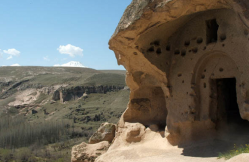 Ihlara - Des archéologues turcs ont en effet découvert une mosquée et une église l’une à côté de l'autre ; toutes les deux ont été construite dans les roches de la célèbre vallée d'Ihlara. Le conservateur du Musée d'Aksaray, Yusuf Altin, a déclaré mercredi dernier que les archéologues continuent leurs recherches sur la découverte du patrimoine culturel dans la vallée d'Ihlara, un village dans province d’Aksaray en Turquie. Dernièrement, les archéologues sont passés de 12 à 25 biens culturels découverts. Mais, c’est la première fois qu'ils ont trouvé une mosquée taillée dans la roche qui avait changé la connaissance commune sur la vallée d'Ihlara, la plus grand zone de la Cappadoce. « Il y avait également une église taillée dans la roche à côté de la mosquée. Cela révèle que, durant la même période, il y avait des musulmans et des chrétiens qui vivaient ensemble dans la vallée d’Ihlara. C’est ainsi que les deux lieux de culte sont si proches l’un de l’autre » a déclaré Yusuf Altin. Il ajoute aussi que la mosquée découverte « a un dôme intérieur et un toit en dôme magnifique. L'intérieur de la mosquée est fascinant. Il y a une porte qui s'ouvre directement à l'extérieur. La caractéristique la plus importante de cette mosquée est qu'elle a été construite à côté d'une église. En fait, l’église a une entrée différente. Les archéologues ont déclaré qu’ils avaient découvert « un atout culturel important en trouvant la mosquée et l'église l’une à côté de l’autre. » La vallée d'Ihlara est une vallée unique en raison de son histoire car c’était un lieu où de nombreuses civilisations ont vécues. De plus, les habitations souterraines et les églises byzantines sont taillées dans la roche.
Ihlara - Des archéologues turcs ont en effet découvert une mosquée et une église l’une à côté de l'autre ; toutes les deux ont été construite dans les roches de la célèbre vallée d'Ihlara. Le conservateur du Musée d'Aksaray, Yusuf Altin, a déclaré mercredi dernier que les archéologues continuent leurs recherches sur la découverte du patrimoine culturel dans la vallée d'Ihlara, un village dans province d’Aksaray en Turquie. Dernièrement, les archéologues sont passés de 12 à 25 biens culturels découverts. Mais, c’est la première fois qu'ils ont trouvé une mosquée taillée dans la roche qui avait changé la connaissance commune sur la vallée d'Ihlara, la plus grand zone de la Cappadoce. « Il y avait également une église taillée dans la roche à côté de la mosquée. Cela révèle que, durant la même période, il y avait des musulmans et des chrétiens qui vivaient ensemble dans la vallée d’Ihlara. C’est ainsi que les deux lieux de culte sont si proches l’un de l’autre » a déclaré Yusuf Altin. Il ajoute aussi que la mosquée découverte « a un dôme intérieur et un toit en dôme magnifique. L'intérieur de la mosquée est fascinant. Il y a une porte qui s'ouvre directement à l'extérieur. La caractéristique la plus importante de cette mosquée est qu'elle a été construite à côté d'une église. En fait, l’église a une entrée différente. Les archéologues ont déclaré qu’ils avaient découvert « un atout culturel important en trouvant la mosquée et l'église l’une à côté de l’autre. » La vallée d'Ihlara est une vallée unique en raison de son histoire car c’était un lieu où de nombreuses civilisations ont vécues. De plus, les habitations souterraines et les églises byzantines sont taillées dans la roche.
http://www.mooslym.com/accueil/culture/488-turquie-decouverte-archeologique-une-mosquee-creuse-dans-la-roche.html
EGYPTE – 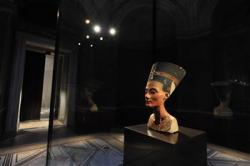 Amarna - Berlin’s Egyptian Museum has said that it will celebrate the centenary of the discovery of the 3,400-year-old fabled bust of Egypt’s Queen Nefertiti amid an ongoing feud with Cairo over its ownership. The museum said it would open an exhibition on Dec. 6 honoring the famous sculpture and other jewels of the Amarna period in its collection on the German capital’s Museum Island. On the same day in 1912, the bust was unearthed by German archaeologist Ludwig Borchardt. Nefertiti, renowned as one of history’s great beauties, was the wife of Pharaoh Akhenaton, remembered for having converted his kingdom to monotheism with the worship of one sun god, Aton. The bust is at the top of a “wish list” of five major artifacts exhibited abroad that Egypt wants returned as part of its cultural heritage. Germany says the sculpture was bought legally by the Prussian state, and that there are documents to prove it. Amarna refers to the ruins of an ancient city founded by Akhenaton, where Borchardt and his team excavated up to 7,000 archaeological objects, about 5,500 of which made their way to Berlin, according to the museum. The Berlin exhibition, entitled “In the Light of Amarna,” will run until April 13, 2013 and feature about 600 of these objects including Akhenaton and Nefertiti’s restored thrones with carved floral garlands.
Amarna - Berlin’s Egyptian Museum has said that it will celebrate the centenary of the discovery of the 3,400-year-old fabled bust of Egypt’s Queen Nefertiti amid an ongoing feud with Cairo over its ownership. The museum said it would open an exhibition on Dec. 6 honoring the famous sculpture and other jewels of the Amarna period in its collection on the German capital’s Museum Island. On the same day in 1912, the bust was unearthed by German archaeologist Ludwig Borchardt. Nefertiti, renowned as one of history’s great beauties, was the wife of Pharaoh Akhenaton, remembered for having converted his kingdom to monotheism with the worship of one sun god, Aton. The bust is at the top of a “wish list” of five major artifacts exhibited abroad that Egypt wants returned as part of its cultural heritage. Germany says the sculpture was bought legally by the Prussian state, and that there are documents to prove it. Amarna refers to the ruins of an ancient city founded by Akhenaton, where Borchardt and his team excavated up to 7,000 archaeological objects, about 5,500 of which made their way to Berlin, according to the museum. The Berlin exhibition, entitled “In the Light of Amarna,” will run until April 13, 2013 and feature about 600 of these objects including Akhenaton and Nefertiti’s restored thrones with carved floral garlands.
http://www.hurriyetdailynews.com/berlin-marks-100-years-of-discovering-nefertiti.aspx?pageID=238&nID=28914&NewsCatID=375
TURQUIE – 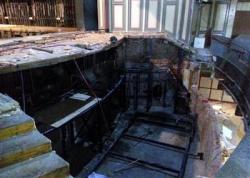 Ankara - Human bones and a skull have been discovered under the stage at the historical Ankara Opera House, home of the Ankara State Opera and Ballet (ADOB), during renovations. During the renovations, a skull, arm, leg bones and pottery were discovered 25 to 30 meters under the stage. The directorate informed the Culture and Tourism Ministry about the findings and archaeologists from the Cultural Heritage and Museums General Directorate investigated the area. ADOB director Aykut Çınar told Hürriyet that the stage elevators were being renovated. “There is a platform approximately 25 to 30 meters under the stage where the elevator hoist mechanism is. The mechanism was removed to be changed since these machines are very old. Excavation was necessary for their removal.” He said a report would be prepared about the findings. “We have heard that the finds are most probably from the Roman period, but we are waiting for the official report. The excavation work is done and the archaeologist has left the site. We have delivered the bones to the Museum of Anatolian Civilizations,” Çınar said. According to some resources, the area was an Armenian cemetery during the Ottoman Empire, which might be the source of the remains.
Ankara - Human bones and a skull have been discovered under the stage at the historical Ankara Opera House, home of the Ankara State Opera and Ballet (ADOB), during renovations. During the renovations, a skull, arm, leg bones and pottery were discovered 25 to 30 meters under the stage. The directorate informed the Culture and Tourism Ministry about the findings and archaeologists from the Cultural Heritage and Museums General Directorate investigated the area. ADOB director Aykut Çınar told Hürriyet that the stage elevators were being renovated. “There is a platform approximately 25 to 30 meters under the stage where the elevator hoist mechanism is. The mechanism was removed to be changed since these machines are very old. Excavation was necessary for their removal.” He said a report would be prepared about the findings. “We have heard that the finds are most probably from the Roman period, but we are waiting for the official report. The excavation work is done and the archaeologist has left the site. We have delivered the bones to the Museum of Anatolian Civilizations,” Çınar said. According to some resources, the area was an Armenian cemetery during the Ottoman Empire, which might be the source of the remains.
http://www.hurriyetdailynews.com/bones-skull-revealed-in-opera-stage-renovation.aspx?pageID=238&nID=28924&NewsCatID=375